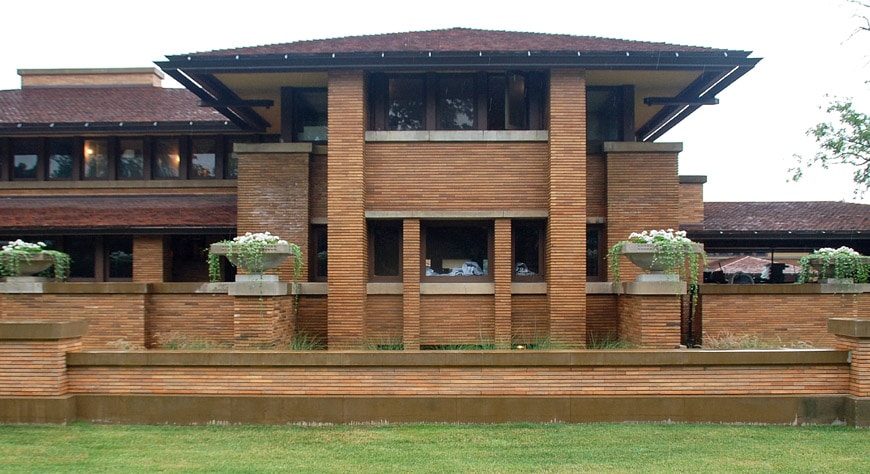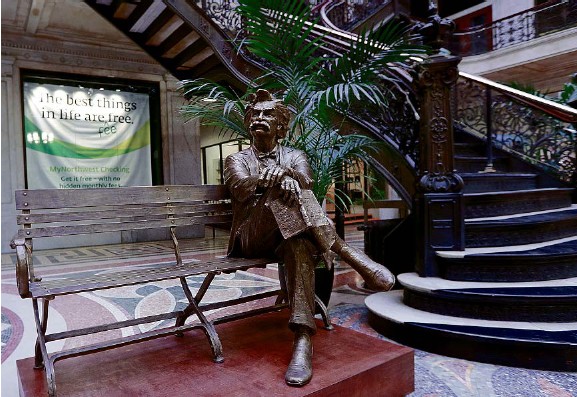 We had really been lucking out during this whole trip with the weather – not only had it been cool and dry most days, but we
also had very little rain. When we did have showers, they only lasted
for a brief time, and usually after we had done whatever activity that was planned
for the day.
We had really been lucking out during this whole trip with the weather – not only had it been cool and dry most days, but we
also had very little rain. When we did have showers, they only lasted
for a brief time, and usually after we had done whatever activity that was planned
for the day.
Unfortunately, the atmosphere around Buffalo
was a little unsettled. Although it was still relatively dry and cool, there were
thunderstorms lurking about nearly every day, a situation I’m sure was
influenced by the Great Lakes moisture.
Sue and I took umbrellas with us when we
went on a downtown walk on Wednesday afternoon. We parked near the Old Post
Office, built in 1901 and now home to SUNY Erie Community College. The Gothic
Revival structure was actually designed by the Office of the Supervising
Architect, an agency of the United States Treasury Department that
planned federal government buildings from 1852 to 1939. “What a place
to go to community college courses!” I said to Sue.
Architecture in Buffalo,
especially the buildings constructed between the Civil War and the Great
Depression, is said to have created a new, distinctly American form and to have
influenced design throughout the world. Within a couple blocks we could see the
gold-leaf dome of the Buffalo Savings Bank, a Beaux-Arts-style structure from
1901, designed by Buffalo architect E.B. Green...
...and the stunning terracotta decoration on the façade of the
Prudential (Guaranty) Building, Louis Sullivan’s extraordinary 1896 design.
Our main destination was the Ellicott Square
Building, named for Joseph Ellicott, on whose original estate this building was
erected. Ellicott was an agent of the Holland Land Company, and in 1803, he
laid out the village of New Amsterdam, now the city of Buffalo. His heirs
commissioned Daniel Burnham to design what became at that time the world’s
largest office building.
Daniel Burnham is a
personal favorite of mine, as he designed the spectacular Pennsylvania Station in Pittsburgh. Folks from the Philadelphia area will be
familiar with his Wanamaker Department Store (now Macy’s); most people would easily
recognize the Flatiron Building in NYC or Union Station in Washington, D.C., among
many of his marvelous structures across the country. His architectural mantra was
"make no little plans, they have no magic to stir men’s blood; think big.”
The Ellicott Square
Building was completed 1896 in the Italian Renaissance style, using granite,
iron, and terra cotta with a veneer of pearl-gray brick. The grand
interior courtyard contains a marble mosaic floor, made up of 23 million pieces
of marble imported from Italy, depicting sun symbols from civilizations around
the world.
In one corner of
the courtyard is a wonderful bronze statue of Mark Twain on a bench. The great
author lived in the city 1869-1871, when he was the co-editor of The Buffalo
Express, which had its newspaper office on the eventual site of the Ellicott
Square Building.
We concluded our little stroll along Main
Street, following the Metro Rail route, down the “sports corridor” from Sahlen
Field, the home of the Bisons, the Toronto Blue Jays AAA baseball affiliate, to
Key Bank Center, the home of the National Hockey League’s Sabres.
After dinner, Sue and I went to see Shakespeare in Delaware Park,
one of the largest free outdoor Shakespeare festivals in the country. Now a
44-year tradition, the organization usually puts on two productions, each for half
of the summer months, Tuesday-Sunday evenings. We saw Love’s Labour’s Lost,
a wonderfully funny play done very well by the cast!
There were strong thunderstorms forecast for
later Thursday afternoon, so we drove out early to Tonawanda so that we could get
in (at least) a ride on the Erie Canalway Trail out to Lockport and back before
the bad weather started. The first couple miles of the trail were through parks
that lined the canal, and there were a few people out in their kayaks enjoying
the cool morning air.
I had scouted out our route pretty well the
night before, using the Rails-To-Trails website Trail Link map in combination
with GoogleMaps street view, as I knew that there were some unconnected segments
of the canal trail that required some on-road “detours”. The first one came
fairly early when Tonawanda Creek Road veered to the right to cut off a big bend
in the canal where a cemetery was located.
It’s a good thing I did check the route,
because there were a couple points later were the trail ended with a sign simply
telling you “Trail Ends” with no direction. Granted, you could generally just
follow the canal and pick up the trail again, but there was a confusing area
where the Tonawanda Creek and Erie Canal form a wye, and it might not be so
obvious to the geographically challenged which branch of water you should be
following.
Even with my double-checking, I made a small
error by taking the first of two bridges towards the hamlet of Pendleton
Center, instead of the town of Pendleton, but we had an idea that we were moving at the
wrong compass heading and corrected our route. I stopped to ask someone, just
to make sure we were going the right way, and was amused that she was used to giving directions to cyclists in the area because of the “less-than-perfect
markings”.
The width of the path narrowed greatly once
out of the park areas, but it was all paved, though the quality
of asphalt varied. When we pedaled onto a very new section of trail that was cleared of the
trees that are pretty much a constant presence along the canal, we noticed the
sky becoming really dark to the north. We were hoping it was moving off, based
on what the weatherman had predicted.
We reached Lockport in time to see a motorboat
pull out of lock 35 and just before hearing the first rumble of thunder.
Locks 34 and 35 bypassed the old Flight of
Five locks that carried boats a change in 60 feet of elevation at the Niagara Escarpment.
The five locks are currently undergoing a restoration project that will allow tourists
to ride a replica canal boat through the Lockport landmark.
Sue and I took refuge in the local library
for an hour or so, until the storm blew over. The temperature had dropped about
ten degrees, and it wasn’t that warm in the first place, so we were dreading a
cold, wet ride back to Tonawanda. Fortunately, things cleared up nicely, and
but for a couple miles of splashing through puddles, the wind and sun helped to dry
out our riding surfaces fairly quickly.
My original plan was to do a bit of
exploring and ride back to Buffalo on my own, and I was glad the weather was
giving me a break, though the wind was kicking up and waves of clouds had me
thinking I shouldn’t dally! I first rode into North Tonawanda to find a couple
more train stations and immediately noticed the corner light posts had carousel
horses attached to them.
On Thompson Street is the Herschel Carrousel
Factory and Museum, which sits nicely along the city’s Heritage Trail that runs
diagonally across a few blocks on the former right-of-way of the New York
Central Railroad. The museum had a few kiddie rides operating outside for the
summer.
I did a sharp turn to head down the short
trail and was surprised to find a boarded-up interlocking tower. This structure
would have housed a towerman who controlled movements between the two intersecting
railroads (in this case the NYC and Erie) with signals and perhaps operated a
switch or two in the area, using large, powerful levers. Interlocking towers used
to be all over the country, until the operations became automated and were controlled
from a distance at a railroad’s division headquarters. Most towers were eventually
demolished, so finding one still standing, especially when tracks are no longer in place, is a bit rare.
Just over the Erie Canal, in the town of Tonawanda,
was the excellent Tonawanda Rails To Trails, an excellent newly-paved route
with attractive plantings and road markers that included upcoming intersections
and the distance to them. My only complaint would be that
it is fairly short, as I turned west at its terminus on Kenmore Avenue after a
little less than five miles.
I made a left turn on Starin Avenue, into
the Central Park section of Buffalo, to find a train station with an
interesting history. Once a property of the Buffalo Cement Company on the Belt
Line railroad, the station was leased by the New York Central. The railroad carried
freight and passengers for about thirty years and helped the neighborhoods grow
around the perimeter of the city during the early 1900s.
Use of the Belt Line faded with the development
of trolley routes and the increased use of automobiles, and of the original
nineteen stations that were on the railroad, this is the only one that remains.
The structure was sold to the Boy Scouts in the 1920s and was used as the
headquarters for Troop 12 until after World War II. The station is now a
private residence.
I made a right turn on Amherst Street, then
a right on Summit Avenue to reach the Martin House Complex designed by the
great Frank Lloyd Wright. The series of connected buildings, constructed 1903-1905
for the family of businessman Darwin D. Martin, his sister Delta and her
husband, are said to be the most important project from Wright’s Prairie School era.

I thoroughly enjoyed the day’s ride, despite
the rain break, and realized that, as I made my way past the entrance of the
Buffalo Zoo in the northeast corner of Delaware Park, that the worst hill I
encountered the whole way was the spiral bike/pedestrian bridge that carried
the park trail over the busy Scajaquada Expressway! An additional plus was
that, except for the local neighborhood streets, nearly the complete route was
in a designated bike lane or on a pathway completely separated from traffic.
Sue and I enjoyed our last vacation evening
at a completely gluten-free restaurant outside of Lockport, and I collected
some pastries and baked goods for the ride home the next day. We changed things
up a bit from the usual New York Southern Tier drive along Interstates 86 and
81 to the PA Turnpike, and opted for the developing I-99/U.S. 15 corridor
through upper-central Pennsylvania. The mountains around Tioga State Forest
were beautiful, and the lighter traffic (but really not much slower) on the state
highways in anthracite coal country made for a comparatively relaxing return
home.















No comments :
Post a Comment